Exploring Your Home's Plumbing System Anatomy
Exploring Your Home's Plumbing System Anatomy
Blog Article
This article down the page on the subject of The Inner Workings of Your Home's Plumbing is rather interesting. Read it for yourself and figure out what you think of it.

Recognizing how your home's plumbing system works is crucial for every homeowner. From providing tidy water for alcohol consumption, cooking, and bathing to safely eliminating wastewater, a properly maintained pipes system is crucial for your household's health and wellness and convenience. In this thorough guide, we'll check out the complex network that comprises your home's pipes and deal pointers on upkeep, upgrades, and taking care of usual issues.
Intro
Your home's plumbing system is more than just a network of pipes; it's a complicated system that ensures you have accessibility to tidy water and reliable wastewater removal. Knowing its elements and exactly how they collaborate can aid you protect against costly repairs and ensure everything runs smoothly.
Fundamental Parts of a Pipes System
Pipes and Tubing
At the heart of your pipes system are the pipelines and tubing that carry water throughout your home. These can be made from numerous materials such as copper, PVC, or PEX, each with its advantages in terms of sturdiness and cost-effectiveness.
Components: Sinks, Toilets, Showers, and so on.
Components like sinks, commodes, showers, and bath tubs are where water is made use of in your house. Recognizing just how these components attach to the pipes system assists in identifying troubles and preparing upgrades.
Shutoffs and Shut-off Factors
Valves manage the flow of water in your plumbing system. Shut-off valves are essential during emergency situations or when you require to make repair services, enabling you to isolate parts of the system without interrupting water flow to the entire house.
Water Supply System
Key Water Line
The primary water line links your home to the community water supply or a private well. It's where water enters your home and is dispersed to numerous fixtures.
Water Meter and Stress Regulator
The water meter steps your water usage, while a stress regulatory authority makes sure that water streams at a safe pressure throughout your home's pipes system, stopping damage to pipes and components.
Cold Water vs. Warm water Lines
Comprehending the distinction between cold water lines, which provide water straight from the main, and hot water lines, which lug heated water from the water heater, aids in repairing and preparing for upgrades.
Drain System
Drain Piping and Traps
Drain pipes lug wastewater away from sinks, showers, and toilets to the sewage system or sewage-disposal tank. Traps prevent sewage system gases from entering your home and likewise trap particles that might cause obstructions.
Ventilation Pipelines
Air flow pipes permit air into the drainage system, protecting against suction that might slow water drainage and trigger catches to empty. Correct air flow is important for keeping the stability of your plumbing system.
Value of Proper Water Drainage
Guaranteeing proper drain prevents back-ups and water damage. Consistently cleaning drains pipes and maintaining catches can prevent pricey repairs and expand the life of your plumbing system.
Water Heater
Types of Hot Water Heater
Water heaters can be tankless or standard tank-style. Tankless heaters warm water as needed, while storage tanks keep warmed water for prompt use.
Exactly How Water Heaters Attach to the Plumbing System
Recognizing how hot water heater attach to both the cold water supply and hot water circulation lines helps in identifying concerns like insufficient warm water or leakages.
Maintenance Tips for Water Heaters
On a regular basis purging your water heater to eliminate debris, checking the temperature setups, and inspecting for leaks can expand its life-span and improve power performance.
Usual Plumbing Issues
Leakages and Their Reasons
Leaks can happen because of maturing pipes, loose installations, or high water stress. Addressing leakages immediately protects against water damage and mold growth.
Obstructions and Clogs
Clogs in drains and bathrooms are commonly brought on by flushing non-flushable items or an accumulation of oil and hair. Making use of drainpipe screens and being mindful of what decreases your drains pipes can stop obstructions.
Indicators of Plumbing Problems to Watch For
Low water pressure, sluggish drains pipes, foul odors, or abnormally high water costs are indicators of potential plumbing problems that ought to be dealt with immediately.
Plumbing Maintenance Tips
Routine Assessments and Checks
Arrange yearly pipes assessments to capture concerns early. Try to find indicators of leakages, deterioration, or mineral build-up in taps and showerheads.
DIY Upkeep Tasks
Straightforward jobs like cleansing tap aerators, looking for commode leakages utilizing dye tablet computers, or protecting exposed pipes in cool climates can avoid significant pipes problems.
When to Call a Professional Plumbing Technician
Know when a plumbing issue calls for expert knowledge. Attempting intricate repair work without proper expertise can result in more damages and higher repair prices.
Upgrading Your Pipes System
Factors for Upgrading
Updating to water-efficient fixtures or changing old pipelines can improve water top quality, decrease water costs, and increase the worth of your home.
Modern Plumbing Technologies and Their Advantages
Explore modern technologies like wise leak detectors, water-saving commodes, and energy-efficient hot water heater that can conserve money and reduce ecological effect.
Cost Considerations and ROI
Compute the in advance prices versus long-lasting savings when thinking about plumbing upgrades. Lots of upgrades pay for themselves with reduced energy bills and fewer repair services.
Environmental Effect and Conservation
Water-Saving Fixtures and Devices
Setting up low-flow taps, showerheads, and toilets can dramatically decrease water use without sacrificing performance.
Tips for Lowering Water Usage
Straightforward practices like dealing with leaks immediately, taking much shorter showers, and running full tons of washing and dishes can save water and reduced your utility expenses.
Eco-Friendly Pipes Options
Consider lasting pipes materials like bamboo for floor covering, which is durable and eco-friendly, or recycled glass for counter tops.
Emergency Readiness
Actions to Take During a Pipes Emergency situation
Know where your shut-off valves are located and exactly how to switch off the water supply in case of a burst pipeline or significant leak.
Significance of Having Emergency Get In Touches With Convenient
Keep get in touch with info for neighborhood plumbers or emergency solutions conveniently offered for quick reaction during a plumbing situation.
DIY Emergency Situation Fixes (When Relevant).
Short-term solutions like using duct tape to patch a leaking pipe or putting a pail under a leaking tap can decrease damages until a professional plumbing technician shows up.
Verdict.
Recognizing the makeup of your home's pipes system encourages you to maintain it effectively, conserving money and time on repair services. By complying with regular maintenance regimens and remaining notified regarding modern plumbing modern technologies, you can guarantee your plumbing system operates successfully for several years to find.
Understanding Your Home Plumbing System: A Comprehensive Guide
Plumbing System: The Lifeline of Your Home
At its core, the plumbing system is designed to perform two primary functions: bring fresh water into your home and remove wastewater. The system is a network of pipes, fixtures, and other components that transport water and sewage. Residential plumbing systems include potable water supply lines, drain-waste-vent (DWV) systems, and various plumbing fixtures that make water use in daily tasks possible.
Key Components:
Water Supply: This part of your plumbing system brings municipal water into your home, passing through the main water supply line. It s responsible for supplying all water needs, from drinking to bathing.
Drainage System: It carries waste and water away from your home to the sewer or septic system. This system includes all the piping within your home that leads to external sewage or septic systems.
Vent System: An essential yet often overlooked component, the vent system allows sewer gases to escape and lets air into the drainpipes, ensuring water and waste move correctly through the system.
Fixture: More Than Just Taps and Toilets
Plumbing fixtures are the most interactive parts of the plumbing system, including faucets, showers, toilets, and sinks. Each fixture is connected to the plumbing system and plays a role in either the delivery of freshwater or the disposal of waste and wastewater.
Types of Fixtures:
Faucets and Sinks: Used for washing hands, dishes, and other daily water needs.
Toilets: Dispose of human waste through the sewage system.
Bathtubs and Showers: Provide bathing facilities, requiring both hot and cold water supply.
Water Supply: The Source of Life
The water supply system is a critical component, ensuring that potable water is available throughout your home for various uses, including drinking, cooking, and cleaning. This system consists of pipes that distribute water to different parts of the house, controlled by valves to regulate the water flow.
Types of Plumbing: Materials and Methods
Various types of plumbing systems and materials are used in residential settings, each with its advantages and applications. From copper and PVC pipes for water supply to cast iron and ABS for drainage, the choice of materials can impact the longevity and efficiency of your plumbing system.
https://intownplumbingtx.com/articles/home-plumbing-system-guide/

Understanding Your Home Plumbing System: A Comprehensive Guide
Plumbing System: The Lifeline of Your Home
At its core, the plumbing system is designed to perform two primary functions: bring fresh water into your home and remove wastewater. The system is a network of pipes, fixtures, and other components that transport water and sewage. Residential plumbing systems include potable water supply lines, drain-waste-vent (DWV) systems, and various plumbing fixtures that make water use in daily tasks possible.
Key Components:
Water Supply: This part of your plumbing system brings municipal water into your home, passing through the main water supply line. It s responsible for supplying all water needs, from drinking to bathing.
Drainage System: It carries waste and water away from your home to the sewer or septic system. This system includes all the piping within your home that leads to external sewage or septic systems.
Vent System: An essential yet often overlooked component, the vent system allows sewer gases to escape and lets air into the drainpipes, ensuring water and waste move correctly through the system.
Fixture: More Than Just Taps and Toilets
Plumbing fixtures are the most interactive parts of the plumbing system, including faucets, showers, toilets, and sinks. Each fixture is connected to the plumbing system and plays a role in either the delivery of freshwater or the disposal of waste and wastewater.
Types of Fixtures:
Water Supply: The Source of Life
The water supply system is a critical component, ensuring that potable water is available throughout your home for various uses, including drinking, cooking, and cleaning. This system consists of pipes that distribute water to different parts of the house, controlled by valves to regulate the water flow.
Types of Plumbing: Materials and Methods
Various types of plumbing systems and materials are used in residential settings, each with its advantages and applications. From copper and PVC pipes for water supply to cast iron and ABS for drainage, the choice of materials can impact the longevity and efficiency of your plumbing system.
https://intownplumbingtx.com/articles/home-plumbing-system-guide/
I stumbled upon that blog entry about Understanding Your Home's Plumbing Anatomy while perusing the internet. Liked our review? Please quickly share it. Let others find it. I praise you for your time. Kindly check up our website back soon.
Visit The Following Page Report this page